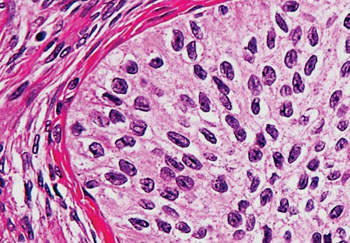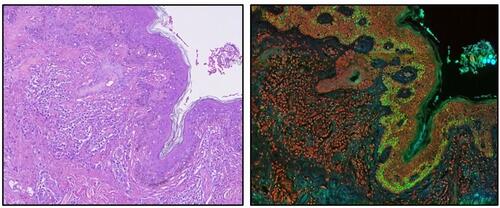Ovarian Cancer Screening Technique Doubles Detection Rates
By LabMedica International staff writers
Posted on 19 May 2015
A risk algorithm using serial biomarker measurements doubles the number of screen-detected ovarian cancers compared to a single threshold rule.Posted on 19 May 2015
The new screening method involves the interpretation of changes in levels a specific protein associated with ovarian cancer, in women's blood. The conventional ovarian cancer screening method uses a fixed "cut-off" point for the specific protein, meaning that the new method is able to predict a woman's individual risk of developing cancer with greater accuracy.

Image: Histopathology of a Brenner tumor, a type of surface epithelial-stromal tumor, which may be benign or malignant, depending on whether the tumor cells invade the surrounding ovarian tissue (Photo courtesy of Nephron).
Scientists at University College London (UK) and their colleagues studied a total of 202,638 post-menopausal women aged 50 and over participated in United Kingdom Collaborative Trial of Ovarian Cancer Screening (UKCTOCS), and were randomly assigned to receive either annual multimodal screening, transvaginal ultrasound or no test at all. They followed up followed up 46,237 women who continued to receive annual multimodal screening. Each participant would have their carcinoma antigen 125 (CA125) levels tested annually over the course of 14 years.
The scientists calculated their risk of ovarian cancer according to the woman's age, their original CA125 levels and how those levels had changed over time. The risk of ovarian cancer was then estimated by comparing the serial pattern with known cases of cancer and controls. Within the group of women receiving multimodal screening, 640 had surgery for suspected cancer. Of these, 133 had invasive epithelial ovarian cancers. Another 22 women were diagnosed with epithelial ovarian cancer within one year of their final annual screen. The team found that found that the new method detected cancer in 86% of women with invasive epithelial ovarian cancer compared with conventional methods used in prior trials or clinical practice that could identify only 41% and 48% respectively. Encouragingly, it ruled out almost 100% of women who were cancer-free. This means these women would not undergo unnecessary further investigation and surgery.
Ian J. Jacobs BA, MA, MBBS, MD, FRCOG, a professor at the University of New South Wales (Sydney, Australia) explained: “CA125 as a biological marker for ovarian cancer has been called into question. Our findings indicate that this can be an accurate and sensitive screening tool, when used in the context of a woman's pattern of CA125 over time. What's normal for one woman may not be so for another. It is the change in levels of this protein that's important.” The study was published on May 4, 2015, in the Journal of Clinical Oncology.
Related Links:
University College London
University of New South Wales













